As a first year MA student of media studies at Film University Babelsberg, I recently had the privilege of attending the ECREA Television Section Conference Redefining Televisuality: Programmes, Practices, Methods, October 25th to 27th in Potsdam, Germany. The conference invited researchers to critically engage and revisit the concept of Televisuality developed by John T. Caldwell. Media plays an influential role in society, and the discussion about representation and diversity is particularly important in today’s world aiming for inclusion. I was particularly interested in the panel “Representation and Diversity” because as a member of the programme committee of our international student film festival Sehsüchte it is particularly important for me to raise awareness of the representation of minorities and marginalised groups and I try to manage this task in the best possible way.
Representation and Diversity in TV
The panel “Representation and Diversity in TV” gathered a diverse group of speakers, each offering unique insights into these matters in relation to television. The first speaker, Traci B. Abbott from Bentley University, USA, presented her research project titled “Gen Z Sexual & Gender Fluidity in US Scripted Television” that investigates US television shows featuring plurisexual and gender non-binary Gen Z characters. Abbott pointed out the stark contrast between the diverse representations on screen and the lack of diversity among the creators behind the screens. Her findings show that the actual majority of all showrunners, directors, writers or producers in scripted television are predominantly white, male, cisgender heterosexual individuals and, within the small percentage of LGTBQ persons in the television industry, the majority are male monosexuals and binary trans persons. This raises the question how filmmakers are able to tell authentic stories of teen relationships, coming of age and the complexities of teen sexuality and gender if most of them are white, male, cisgender, heterosexual and have never gathered comparable experiences?
Abbott furthermore discussed explicit sexual scenes that can be “shocking” or “off-putting” despite their youthful audience, using examples such as Euphoria (2019-present), Genera+ion (2021), and Gossip Girl (2007-2012). She argues that through the portrayed hypersexualization, teens can be negatively impacted, for example by being deterred from exploring their own sexuality, not seeing enough alternative relationship models, and frequently being shown sex in the context of drug use.
Another interesting point was raised by Abbott in the discussion after the panel: whereas in the past there were more sexualised and revealing depictions of women in films and series, now depictions revealing masculinity are increasing. Can this really be seen a reaction of the industry to feminist demands on series content?
Netflix’ Self-promotion
The next speaker, Tim Raats from Vrije Universiteit Brussel, presented the work he published together with Axelle Asmar and Leo van Audenhove “Globalizing difference(s): “Netflix’s teen series and the global localization of diversity”. He stated that SVODs are (re)shaping AV cultures. Netflix and the transnationalisation of TV production caused a change in commissioning strategies (format, volumes, budgets, coproductions, rights and retainment), which was leading into a change in production practices and finally made a change in storytelling practices.
Raats and his co-authors examined how Netflix positions itself as a driver of inclusion for underrepresented communities. Netflix’s marketing strategies revolve around four key narratives: 1. Netflix as the driver for change: the company sees itself safeguarding a representation industry and as a driver for demographic change. 2. Netflix as the future of new talents: through initiatives its communication emphasis is on young and diverse talents. 3. Netflix as the key local investor: Netflix is contributing to the flourishing of local talents and industries. And lastly, 4. Netflix as the window to the world: the company is increasing the global reach of marginalized talents, genres and industries.
While there is no proof yet that this is in fact Netflix’ business strategy, Raats argues that: ”these narratives are more than just branding, but strategic operations of power to ensure premium access to young talents and local industries.“
Queer Televisuality in Australia
Damien O’Meara from Swinburne University of Technology offered a unique perspective on queer televisuality in Australia. The PhD researcher presented his findings on “Queer televisuality: a holistic approach to analysing onscreen LGBTQ+ representations in scripted television“. Drawing on John T. Caldwell’s measures of Televisuality, Damien O’Meara examined queer televisuality in Australia as 1) an industry product, 2) a function of audience, and 3) a product of economic crisis. His work draws on 18 interviews with professionals in the film and television industry. For me it was particularly interesting to learn that the Australian TV market was very limited until 2005 and there were only five channels until then. Queer televisuality, according to O’Meara, only developed in the 2000s-2010s. O’Meara noted that Australia is a small market and relies on government support to produce more diverse films and series. One quote made clear how funding policies influenced onscreen queerness in Australia: “I think when the screen agencies made diversity hiring a part of the funding matrix – i.e. if you didn’t do it, you didn’t get the money – it made a huge difference. And I think it’s also informed the commercial side of the business too. You know, CBS Viacom, now Paramount, won’t give you a green light unless you can demonstrate the diversity, not just in the writing and casting, but in the crew as well“ (David Hannam, Writer and Executive Producer). But O’Meara also points out that even though there are more and more complex narratives, the portrayal of bisexual men, such as in The Newsreader (2021-present), is still very rare. He can see some improvements and efforts towards more diversity in Australian television, but there are still many problems and obstacles to overcome there.
Final Thoughts
The conference provided a wealth of insights into the evolving world of television and the complex issues of representation and diversity within the industry. For me, as a student, it helped to attend such an event to get inspiration for research ideas, get a different perspective on media topics, and on my own media use. While I had fallen in love with the aesthetics of Euphoria, Traci Abbott’s critique of the series opened a different point of view for me which I was not aware of beforehand. However, the discussions also raised some questions. Of course, I see the relevance of looking at “mainstream formats” that reach a particularly large audience. But when it comes to matters of representation of diversity in films and series, I think there should also be mentioning of formats that have achieved less attention and reach.
The panel underscored the need for more diversity behind the scenes, as well as the importance of responsible portrayal of sensitive topics in media. If you want to delve deeper into these topics, I recommend exploring the research of the conference speakers, which offers a more comprehensive understanding of the issues at hand and the potential for change in the realm of television.
Tinett Kähler (*1996) began her career as a graphic designer for digital and print media and gained three years of experience in a marketing agency. She has been working as a freelancer since 2019, focusing on graphic design and photography. Her academic background includes a Bachelor’s degree in Digital Media Culture at the Film University Babelsberg, where her thesis focused on the representations of VTubers (Virtual YouTubers) on Twitch. In October 2023, Tinett began her Master’s in Media Studies at the same university to combine theoretical and practical knowledge of aesthetics, media and communication.
Links + Literature
- Asmar, A., Raats, T., & Van Audenhove, L. (2023). Streaming difference(s): Netflix and the branding of diversity. Critical Studies in Television: The International Journal of Television Studies, 18(1), 24–40. https://doi.org/10.1177/17496020221129516
- Abbott, T. B. (2022). The History of Trans Representation in American Television and Film Genres.Springer International Publishing. https://doi.org/10.1007/978-3-030-97793-1
- O’Meara, D [In Press], ‘The queer television celebrity interview: uncovering the role of the queer national celebrity in Australian television production’, in J McIntyre & A Moore (eds), The Routledge Companion to Gender and Celebrity.
Talks:
- Traci B. Abbott (Bentley University): Gen Z Sexual & Gender Fluidity in U.S. Scripted Television
- Axelle Asmar (Vrije Universiteit Brussel), Tim Raats & Leo van Audenhove: Globalizing difference(s): Netflix’s teen series and the global localization of diversity
- Damien O’Meara (Swinburne University of Technology): Queer televisuality: a holistic approach to analysing onscreen LGBTQ+ representations in scripted television
Biography




